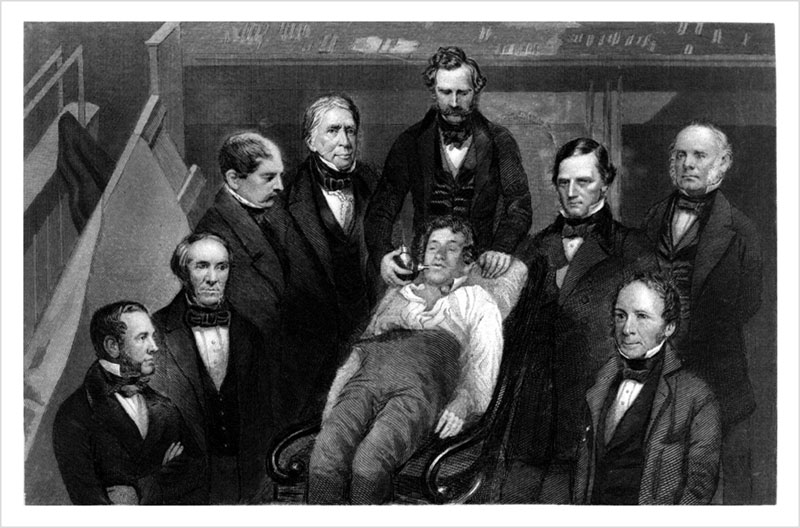

Illustration from Rice, Trials of a Public Benefactor (1859). Original caption reads: "Wm. T. G. Morton, M. D., Boston, making the first public demonstration of etherization at the Massachusetts General Hospital, surrounded by the medical staff of that institution." [From left to right: 1.) Dr. Henry J. Bigelow. 2.) Dr. Augustus A. Gould. 3.) Dr. J. Mason Warren. 4.) Dr. John C. Warren. 5.) Dr. William T. G. Morton. 6.) Dr. Samuel Parkman. 7.) Dr. George Hayward. 8.) Dr. T. D. Townsend.] Archived at the Wellcome Library.
The origin of the reenactment scenario in the literature can be traced back to Henry Bryan Hall's steel engraving published in Trials of a Public Benefactor, authored by Nathan Rice. (18 »») Hall's engraving idealized the Abbott operation, portraying the surgical staff of the Massachusetts General Hospital at the time, plus Morton and his champion Dr. Augustus A. Gould. These were the principals who were most at risk if the experiment had failed, but two participants of the Abbott inner circle were omitted in Hall's engraving: House-surgeon Charles Heywood and House-physician Charles Bertody. And at least two of the Abbott principals named by Hall and Rice were not participants that day: Drs. George Hayward, Jonathan Mason Warren, and possibly Samuel Parkman. The public reception of this idealized fiction was fostered by Rice who wrote, "At this operation there were present in the central circle, in addition to the large number among the packed audience, Drs. J. C. Warren, J. Mason Warren, S. D. Townsend, H. J. Bigelow, Samuel Parkman, George Hayward, Dr. Pierson, of Salem, (subsequently killed at the Norwalk accident,) Dr. Gould, and Dr. Wellington, of Cambridge, Dr. Morton's former preceptor." (19 »»)
For the background of his engraving Hall copied the spatial elements in EDD No. 5, viz., the partition screen, the stretcher propped against the surgical chair, and reflections of light on the glassed instrument cabinet. The prints that were pulled from the plate flipped these compositional elements of the daguerreotype, or rather re-flipped them, since the lens in Hawes's camera itself produced an obverse of the scene. Although his engraving idealized the Abbott operation, Hall skillfully rendered accurate portraits that affirm the identities of Drs. Jonathan Mason Warren, Henry Jacob Bigelow, and Samuel Parkman in Ether Dome Daguerreotype No. 1, the "reenactment" daguerreotype. An earlier state of the engraving provides a plausible attribution for Bertody and will be discussed under Hinckley's painting of the Abbott operation.
Until the close of the 19th century, Hall's engraving remained the sole visual representation of the Abbott surgery, and the public's only exposure to the daguerreotypes that he used as his models. In 1896, reproductions of Hall's engraving began to appear in memoirs celebrating the 50th anniversary of etherization, including one written by Morton's widow, Elizabeth Whitman Morton, published in McClure's Magazine with the caption, "Dr. Morton making the first public demonstration of etherization at the General Hospital, October 16, 1846." (20 »») The Boston Medical & Surgical Journal published several articles commemorating the introduction of anesthesia, illustrated by a phototype of Hall's engraving alongside a view of an artist's mock-up of the Ether Dome amphitheater, "as it was in 1846." (21 »») Subsequent editions of the engraving continued to be published well into the twentieth century, especially around the time of the 75th anniversary of anesthesia.
18.) Rice, N (1859); pl. facing p. 42.
19.) Ibid; p. 94.
20.) Morton, EW (1896), "The discovery of anesthesia. Dr. W. T. G. Morton and his heroic battle for a new idea — how painless surgery began fifty years ago." In: McClure's Magazine. London & New York: The S. S. McClure Co.; vol. 7., p. 311-388, ill.
21.) Hall, HB (1896), "The first public demonstration of etherization at the Massachusetts General Hospital." In: The Boston Medical and Surgical Journal. Boston: Damrell and Upham ; vol. 135, no. 16. Phototypes facing p. 386.
